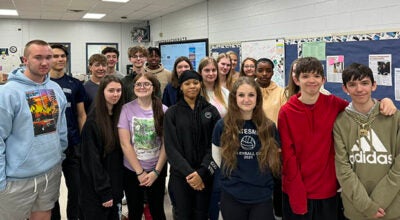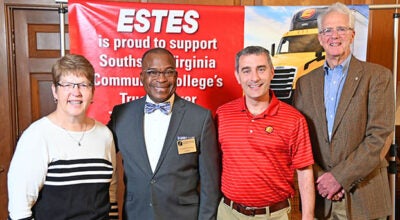Stricter solar setbacks defeated
Published 6:57 pm Tuesday, September 14, 2021
|
Getting your Trinity Audio player ready...
|
Two Board of Supervisors (BOS) quest for more significant setbacks against solar facilities seeking to make Charlotte County their home was defeated Monday, Sept. 12 in a 4-3 vote by the board.
Over the past few weeks, Supervisors Kay Pierantoni and Donna Fore pushed for and received a majority vote for a public hearing on an ordinance that would become stricter.
What came out of the three-hour public hearing was reverting to the planning commission’s original zoning ordinance recommendation, heated conversations, accusations of financial gain, lots of letters read, and citizen after citizen taking to the podium to express support and opposition for solar.
In June, the Planning Commission unanimously voted to amend the zoning ordinance for setbacks and require community meetings for large-scale solar facilities.
The newly amended section of the zoning ordinance called for a minimum setback of 125 feet from the centerline of any state-maintained road abutting the property; a minimum setback of 75 feet from all other property lines except those property lines that are inside the project’s boundaries and which do not abut property located outside the project area; and a minimum of 400 feet from all off-site residential structures unless otherwise prescribed by the Board of Supervisors as a condition of approval for a conditional use permit.
The issue was brought to the Planning Commission in response to comments received regarding several conditional use permit applications for solar projects.
In addition, the BOS requested that the Planning Commission review zoning requirements for utility-scale solar development setbacks and buffers.
It was at the August meeting of the BOS where citizens Rebecca Daly and Rodney Moon presented a new set of setbacks.
After lengthy talks and a call to the county attorney, Pierantoni motioned to reject the Planning Commission’s recommendations on setbacks reading out Daly and Moons a new set of recommended setbacks ranging from 400 feet to 1,000 feet protecting such places as state parks and schools, churches, and residential homes.
When it came time for a vote, Pierantoni and Fore voted yes to reject the Planning Commission’s recommendation, while Supervisor Robert Shook voted no.
During the August meeting Supervisor Garland Hamlett Jr. abstained from voting but did not say why. At Monday’s meeting, Hamlett voted in favor of the stronger setbacks.
Both Chairman Gary Walker and Vice-Chairman Will Garnett were absent during the August meetings vote, as well as Supervisor Tony Reeves, but the three, along with supervisor Robert Shook, voted against the stricter setbacks.
Monday’s Public hearing consisted of determining if the following stricter setback should be approved.
• 250 feet from the centerline of any state-maintained two-lane road abutting the property
• 250 feet from the boundary of any state-maintained roads with more than two lanes abutting the property
• 400 feet from any intersection of any two-lane or more state-maintained roads
• 600 feet from the centerline of any state-designated Scenic Byway
• 600 feet from any church property boundary
• 300 feet from any cemetery not affiliated with a church
• 500 feet from any public school property boundary
• 500 feet from any State recognized historic property boundary
• 500 feet from any State Park property boundary
• 400 feet from any property boundary of any parcel used for residential purposes
• 600 feet from water well that provides water for private residential use
• 1000 feet from any water well that provides water for any public use
• 600 feet from the FEMA 100-year flood boundary of any named stream or river
• 3 feet vertical elevation higher than the elevation of any adjacent designated wetland boundary provided; however that it shall not be less than 50 feet from any adjacent wetland boundary measured horizontally regardless of vertical elevation
• 150 feet from all other property lines of property not zoned for commercial or industrial uses
• 0 feet from those property lines that are inside the project’s boundaries and which do not abut property located outside the project area.
Currently, the county is looking at applications from two different solar companies wishing to build — one in the Randolph area and another near Charlotte Court House.
Gerald Henderson, one supporter of the Randolph solar project, wrote a letter to the BOS concerning the stricter setbacks and Moon’s participation in the ordinance.
“Our family decided together to move forward with participating in the Randolph Solar Project,” Henderson wrote. “We feel that this project not only will financially help our family but will be a substantial tax revenue source for the county and the immediate community. Mr. Moon has, on many occasions, tried to purchase portions of our family’s property for his own personal gain. Because he was unsuccessful, he is now trying to sabotage this project. He should be barred from having any significant input and should not be a part of any discussions with elected officials. His personal interests have compromised his judgment. This is our land, and as a family, we’ve made this decision together along with the many other families involved in this project.”
Moon addressed the BOS twice during Monday’s meeting, once stating he had a petition of more than 200 signatures representing citizens who did not favor the planning commissions zoning amendments, specifically the proposed setbacks and buffers and second questioning the lack of county citizens who spoke against the stronger setbacks.
Moon said that most of the letters that were read in favor of solar stemmed from words used in a letter from Francis Hodsoll, CEO of SolUnesco, the developer of the Randolph Solar project.
Late last week, a letter from Hodsoll was circulating on social media.
A portion of the letter read:
“I ask that you show up, write a letter or write an email opposing Rodney Moon’s setback proposal. Please let the Board know that Arbitrary, excessive, and overly complex restrictions on solar will kill future projects. If you kill solar, you kill their investment in the community, revenues to the county and money for Charlotte County’s landowners.
In his letter, Hodsoll wrote, “Randolph Solar will invest $600 million in local goods and services, revenues to the county, and money to the landowners.”
In responding to a question about the letter, Hodsell said, “We try to keep all of our landowners informed about what is going on.”
Though most citizen letters read were in favor of solar and against the newly proposed setbacks, those who addressed the BOS in person were in favor of stricter setbacks.
“I object to the Randolph Solar project,” said Sue Adams. “It’s not a good place for you to come and destroy our roads, degrade our property values, destroy our wildlife, poison our soil and intrude on our way of life … our community leaders have let us down.”
Following the 4-3 failed vote for more substantial setbacks, Vice-Chairman Will Garnett made a motion to adopt the planning commission’s original recommendations; Supervisor Shook seconded with the motion passing 4-3 with Chairman Walker and supervisor Reeves voting in favor of the motion.
On Tuesday afternoon Hodoll said his company was appreciative of all the support it received and the recognition that Rodney Moon’s proposed Setbacks were excessive and unworkable. “Further, we appreciate the hard work of the planning commission, the county staff, and the Board,” Hodsoll said. “We understand that there are differing opinions and hope that we can all respect these differences.”
Supervisor Fore further commented “I wish that more people had been listening,” she said. When hard working, honest citizens of this county either show up in person or write letters to their government, and then they get ignored, I’m speechless.”



